Defect Index of Timberwork in House, Korea
Abstract
:1. Introduction
- Gap difference in wooden ceiling frames
- No installation of wooden floor under kitchen
- Mismatch of wooden floor molding
- No installation of wooden door edge finishing
- Poor opening and closing of wooden windows
- Default in installation, poor opening and closing, and sheet falling in the rooms and kitchen furniture
- No installation of wooden floor in the lower parts of the kitchen
- No installation of wooden door edge finishing
- Poor opening and closing of wooden windows
2. Materials and Methods
2.1. Target Object
2.2. Process
- Appraisal Reports and decisions of housing defect lawsuits were collected as case study materials.
- Standard defect index was established based on the case study.
- The number of case and defect repair cost ratios per defect index were calculated.
- A separate prime index was established with only defect indices higher than average.
- The defect repairing cost ratios between the prime index and the index suggested in the previous study were compared.
2.3. Method
2.3.1. Case Collection
2.3.2. Index Standardization of Defect Type
- Extraction of defect items from the appraisal report and judgment decision by each case.
- Grouping the defect items of Step 1 among similar items.
- Categorization of defect occurrence timing into occurring defect before handover and occurring defect after handover.
- For Step 3, categorization of facility works (wooden work, window work, finishing, and miscellaneous works) related to woodworking in the Housing Act.
- For Step 4, categorization according to location and area where the defect occurs.
- Categorization according to the subject of defect for Step 5 (categorized into being more specific than Step 5, which can be omitted)
- Categorization by a phenomenon in questions for Steps 5 and 6.
2.3.3. Comparison Factor Suggestion
2.3.4. Prime Index Draw and Comparison
3. Results
3.1. Case Outline
3.2. Defect Index A
3.3. Defect Occurrence and Repairing Cost Ratio
3.4. Defect Index A Prime
3.5. Defect Index B
3.6. Defect Index C
3.7. Comparison of Indices
4. Discussion
5. Conclusions
Author Contributions
Funding
Institutional Review Board Statement
Informed Consent Statement
Data Availability Statement
Conflicts of Interest
References
- Zeide, B. The science of forestry. J. Sustain. For. 2008, 27, 345–473. [Google Scholar] [CrossRef]
- Puletti, N.; Giannetti, F.; Chirici, G.; Canullo, R. Deadwood distribution in European forests. J. Maps 2017, 13, 733–736. [Google Scholar] [CrossRef]
- Kim, D.-J. An open-door policy on forests in the 15th∼19th centuries Korea, and changes in the forests themselves. YŎKSA WA HYŎNSIL Q. Rev. Korean Hist. 2017, 103, 77–118. [Google Scholar] [CrossRef]
- Jin, E.; Chung, Y.-J. Kangwon National University fire risk of wood treated with boron compounds by combustion test. Fire Sci. Eng. 2018, 32, 19–26. [Google Scholar] [CrossRef]
- An, D.W. Sustainability and variability of Korean wooden architectural heritage: The relocation and alteration. Sustainability 2018, 10, 1742. [Google Scholar] [CrossRef] [Green Version]
- Choi, S.-G.; Choi, Y.-J.; Nam, Y.-J.; Kim, S.-K. Fire Detection tendency through combustion products generated during UL 268 wood flame fire and smoldering fire test. Fire Sci. Eng. 2021, 35, 48–57. [Google Scholar] [CrossRef]
- Viholainen, N.; Kylkilahti, E.; Autio, M.; Toppinen, A. A home made of wood: Consumer experiences of wooden building materials. Int. J. Consum. Stud. 2020, 44, 542–551. [Google Scholar] [CrossRef]
- Kim, Y.; You, K. The study to environmental factors using microclimate survey of traditional wooden Silsang Temple in Korea. Environ. Monit. Assess. 2018, 190, 630. [Google Scholar] [CrossRef] [PubMed]
- Novita, N.; Amiruddin, H.; Ibrahim, H.; Jamil, T.M.; Syaukani, S.; Oguri, E.; Eguchi, K. Investigation of termite attack on cultural heritage buildings: A case study in Aceh Province, Indonesia. Insects 2020, 11, 385. [Google Scholar] [CrossRef] [PubMed]
- Son, D.; Lee, D. Evaluation on termite damage of the traditional wooden building by non-destructive methods. J. Korean Wood Sci. Technol. 2008, 36, 21–29. [Google Scholar]
- Ferrandez-Villena, M.; Ferrandez-Garcia, C.E.; Garcia-Ortuño, T.; Ferrandez-Garcia, A.; Ferrandez-Garcia, M.T. Analysis of the thermal insulation and fire-resistance capacity of particleboards made from vine (Vitis vinifera L.) prunings. Polymers 2020, 12, 1147. [Google Scholar] [CrossRef] [PubMed]
- Okahisa, Y.; Narita, C.; Yoshimura, T. Resistance of wood coated with oriental lacquer (urushi) against damage caused by subterranean termite. J. Wood Sci. 2019, 65. [Google Scholar] [CrossRef]
- Ahmed, S.; Arocho, I. Feasibility assessment of mass timber as a mainstream building material in the US construction industry: Level of involvement, existing challenges, and recommendations. Pract. Period. Struct. Des. Constr. 2021, 26, 04021008. [Google Scholar] [CrossRef]
- Chang, Y.; Kim, S.; Son, W.; Lee, S.; Shim, K.; Yeo, H.; Kim, K. Assessment of carbon emission for quantification of environmental load on structural glued laminated timber in Korea. J. Korean Wood Sci. Technol. 2016, 44, 449–456. [Google Scholar] [CrossRef] [Green Version]
- Dimitriou, A.; Roberts, P.; Ormondroyd, G. VOC emissions from the combustion of low-grade lignocellulosic waste. Int. Wood Prod. J. 2018, 9, 151–156. [Google Scholar] [CrossRef]
- Ryoo, S.; Youn, H. The evolutionary use of curved wood in korean traditional architecture. Sustainability 2019, 11, 6557. [Google Scholar] [CrossRef] [Green Version]
- Hong, S. A study on the constructional layout and changes of Chuncheon-Gwana and Chuncheon-Igung. J. Stud. Kangwon Community Cult. 2019, 39, 3–29. [Google Scholar]
- Lee, J.; An, D. Selecting the restoration period and source material in the restoration of early Joseon Buddhist temples in Korea. J. Asian Archit. Build. Eng. 2019, 18, 554–574. [Google Scholar] [CrossRef]
- Rho, J.; Han, S.; Kim, S.; Choi, J. Cultural memories and imaginary environments projected in landscapes. J. Korean Inst. Tradit. Landsc. Archit. 2017, 15, 15–22. [Google Scholar]
- Choi, J. A study on the landscape conservation and management of Dodong Seowon, Unesco World Heritage. J. Korean Inst. Tradit. Landsc. Archit. Int. Ed. 2019, 17, 42–48. [Google Scholar]
- Kim, G.; Lee, J. The impact of historic building preservation in urban economics: Focusing on accommodation prices in Jeonju Hanok Village, South Korea. Sustainability 2020, 12, 5005. [Google Scholar] [CrossRef]
- McNitta, D.; Alonso, R.; Cherry, M.; Fies, M.; Kellya, M. Influence of forest disturbance on bobcat resource selection in the Central Appalachians. For. Ecol. Manag. 2020, 465, 118066. [Google Scholar] [CrossRef]
- Nepomuceno, Í.; Affonso, H.; Fraser, J.; Torres, M. Counter-conducts and the green grab: Forest peoples’ resistance to industrial resource extraction in the Saracá-Taquera National Forest, Brazilian Amazonia. Glob. Environ. Chang. 2019, 56, 124–133. [Google Scholar] [CrossRef]
- Potter, C.; Kim, J. Austerity in reverse: Korea, capabilities, and crisis. Int. Plan. Stud. 2020, 25, 9–22. [Google Scholar] [CrossRef]
- Yoo, M. Ulleungdo situation and Japanese resource exploitation revealed by field survey in Korean empire period. Ocean Policy Res. 2018, 33, 15–57. Available online: https://www.kci.go.kr/kciportal/ci/sereArticleSearch/ciSereArtiView.kci?sereArticleSearchBean.artiId=ART002366772 (accessed on 20 February 2021).
- Institute for Military History. Statistics on Korean War Damage; Ministry of National Defence: Seoul, Korea, 1996; p. 89. Available online: http://theme.archives.go.kr/viewer/common/archWebViewer.do?bsid=200041027865&gubun=search (accessed on 20 February 2021).
- Lee, S. A study on Incheon and the oral history of Korean war. J. Incheon Stud. 2021, 34, 137–185. Available online: http://www.dbpia.co.kr/journal/articleDetail?nodeId=NODE10532590 (accessed on 20 February 2021). [CrossRef]
- Grange, A.; Jung, H. The commodification of land and housing: The case of South Korea. Hous. Stud. 2004, 19, 557–580. [Google Scholar] [CrossRef]
- Sung, C.; Kim, J.; In, S. Small and medium-sized enterprises policy in Korea from the 1960s to the 2000s and beyond. Small Enterp. Res. 2016, 23, 262–275. [Google Scholar] [CrossRef]
- Park, J.; Seo, D. Construction defect and maintenance problem of watering apparatus and sanitary work in apartment building. Int. J. Adv. Sci. Technol. 2020, 29, 949–961. Available online: http://sersc.org/journals/index.php/IJAST/article/view/6553/3972 (accessed on 20 February 2021).
- Jang-Hwan, J.; So-Hee, P.; JaChoon, K.; Taewoo, R.; Lim, E.M.; Yeo-Chang, Y. Preferences for ecosystem services provided by urban forests in South Korea. For. Sci. Technol. 2020, 16, 86–103. [Google Scholar] [CrossRef]
- Lawson, J. Transformation in and challenges to the Korean housing solution. J. Asian Public Policy 2008, 1, 313–327. [Google Scholar] [CrossRef]
- Kim, Y.; Choi, M. Why have big construction companies replaced real estate developers in Korea? Int. J. Urban Sci. 2015, 19, 206–223. [Google Scholar] [CrossRef]
- Holmans, A. New estimates of housing demand and need in England, 2011 to 2031. Town Ctry. Plan. Tomorrow Ser. 2013, 16, 1–32. [Google Scholar]
- Department for Communities and Local Government. Live Tables on House Building—Statistical Data Sets. Available online: http://bit.ly/234uxQc (accessed on 17 October 2020).
- Zaneldin, E. Investigating the types, causes and severity of claims in construction projects in the UAE. Int. J. Constr. Manag. 2020, 20, 385–401. [Google Scholar] [CrossRef]
- Zaneldin, E. Construction claims in United Arab Emirates: Types, causes, and frequency. Int. J. Proj. Manag. 2006, 24, 453–459. [Google Scholar] [CrossRef] [Green Version]
- Noble-Allgire, A. Notice and opportunity to repair construction defects: An imperfect response to a perfect storm. Real Prop. Trust Estate Law J. 2009, 43, 729–796. [Google Scholar]
- Tazelaar, F.; Snijders, C. Dispute resolution and litigation in the construction industry: Evidence on conflicts and conflict resolution in the Netherlands and Germany. J. Purch. Supply Manag. 2010, 16, 221–229. [Google Scholar] [CrossRef]
- UK Commission for Employment and Skills, Sector Skills Insights: Construction, Evidence Report 50, UK Commissions for Employment and Skills. 2012. Available online: https://assets.publishing.service.gov.uk/government/uploads/system/uploads/attachment_data/file/304475/Sector_Skills_Insights_Construction_evidence_report_50.pdf (accessed on 17 October 2020).
- Home Builders Federation, the Economic Footprint of UK House Building, Home Builders Federation, 2015. Available online: https://www.hbf.co.uk/documents/6203/Economic_Fotprint_BPF_Report_March_2015_WEB.pdf (accessed on 17 October 2020).
- Hopkin, T.; Lu, S.; Rogers, P.; Sexton, M. Detecting defects in the UK New-build housing sector: A learning perspective. Constr. Manag. Econ. 2016, 34, 35–45. [Google Scholar] [CrossRef]
- Park, J.; Seo, D. Defect occurrence pattern of wood work in apartment building. Int. J. Adv. Sci. Technol. 2020, 29, 942–948. Available online: https://http://sersc.org/journals/index.php/IJAST/article/view/6553/3971 (accessed on 20 February 2021).
- Abdou, A.; Haggag, M.; Khatib, O. Use of building defect diagnosis in construction litigation: Case study of a residential building. J. Leg. Aff. Disput. Resolut. Eng. Constr. 2015, 8, C4515007. [Google Scholar] [CrossRef]
- Seo, D.; Park, J. Analysis of consulting reports on defect disputes in apartment building. J. Korea Inst. Build. Constr. 2013, 13, 498–505. [Google Scholar] [CrossRef] [Green Version]
- Lynda, A.; Bennett, E. Deconstructing the construction defect insurance claim. Environ. Claims J. 2008, 20, 160–180. [Google Scholar] [CrossRef]
- Park, J.; Seo, D. Trend of defect occurrence between painting work and finish work in apartment building. Int. J. Recent Technol. Eng. 2019, 8, 927–931. [Google Scholar] [CrossRef]
- Iwamatsu, J.; Akiyama, T.; Endo, K. Construction claims and disputes and the business culture of construction in Japan. J. Prof. Issues Eng. Educ. Pract. 2008, 134, 119–127. [Google Scholar] [CrossRef]
- National Law Information Center, Enforcement Decree of the Housing Act, South Korea. 2007. Available online: http://www.law.go.kr/engLsSc.do?menuId=1&subMenuId=21&query=%EC%A3%BC%ED%83%9D%EB%B2%95%20%EC%8B%9C%ED%96%89%EB%A0%B9# (accessed on 20 February 2021).
- Park, J.; Seo, D. Defect repairing cost and its bond on apartment building in relation to lawsuit parties. Int. J. Innov. Technol. Explor. Eng. 2019, 9, 4882–4887. [Google Scholar] [CrossRef]
- Society for Construction Lawsuit in Seoul Central District Court. Construction Appraisal Practice, 3rd ed.; Society for Construction Lawsuit in Seoul Central District Court: Seoul, Korea, 2016. (In Korean)
- Park, J.; Seo, D.; Um, S.; Kim, C. Defect types of electrical work in house construction. Solid State Technol. 2020, 63, 6428–6443. [Google Scholar]
- National Law Information Center, a Judged Standard, Investigated Method and Estimated Costing of Defect in Dwelling House, South Korea. 2016. Available online: http://www.law.go.kr/admRulSc.do?menuId=5&query=%ED%95%98%EC%9E%90%ED%8C%90%EC%A0%95#liBgcolor0 (accessed on 20 February 2021). (In Korean)
- Kim, B.; Park, J.; Choi, J.; Seo, D.; Kim, O. Comparative analysis on repairing cost of lawsuit on concrete crack defect in apartment building. Korea J. Constr. Eng. Manag. 2011, 12, 142–150. [Google Scholar]
- Seo, J. Model for Predicting the Occurrence of Defects in High-Rise Residential Building. Ph.D. Thesis, Korea University, Seoul, Korea, 2009. (In Korean). [Google Scholar]
- Seo, D.; Park, J. Comparative analysis on landscape work defect types in apartment buildings through defect dispute case. Asia Life Sci. 2018, 15, 1719–1730. [Google Scholar]
- Chong, W.; Low, S. Latent building defects: Causes and design strategies to prevent them. J. Perform. Constr. Facil. 2006, 20, 213–221. [Google Scholar] [CrossRef] [Green Version]
- Vásquez-Hernández, A.; Botero, L. Standardizing system of posthandover defects for the construction sector in Colombia. J. Archit. Eng. 2019, 25, 05019004. [Google Scholar] [CrossRef]
- Delgado, A.; Brito, J.; Silvestre, J. Inspection and diagnosis system for wood flooring. J. Perform. Constr. Facil. 2013, 27, 564–574. [Google Scholar] [CrossRef]
- Mousavi, M.; Taskhiri, M.; Holloway, D.; Olivier, J.; Turner, P. Feature extraction of wood-hole defects using empirical mode decomposition of ultrasonic signals. NDT E Int. 2020, 114, 102282. [Google Scholar] [CrossRef]
- Sassu, M.; Falco, A. Legal disputes and building defects: Data from Tuscany. J. Perform. Constr. Facil. 2014, 28, 04014017. [Google Scholar] [CrossRef] [Green Version]
- Walsh-Korb, Z.; Avérous, L. Recent developments in the conservation of materials properties of historical wood. Prog. Mater. Sci. 2019, 102, 167–221. [Google Scholar] [CrossRef]
- Du, X.; Feng, H.; Hu, M.; Fang, Y.; Chen, S. Three-dimensional stress wave imaging of wood internal defects using TKriging method. Comput. Electron. Agric. 2018, 148, 63–71. [Google Scholar] [CrossRef]
- Kamal, K.; Qayyum, R.; Mathavan, S.; Zafar, T. Wood defects classification using laws texture energy measures and supervised learning approach. Adv. Eng. Inform. 2017, 34, 125–135. [Google Scholar] [CrossRef]
- Shi, J.; Li, Z.; Zhu, T.; Wang, D.; Ni, C. Defect detection of industry wood veneer based on NAS and multi-channel mask R-CNN. Sensors 2020, 20, 4398. [Google Scholar] [CrossRef] [PubMed]
- Korea Ministry of Government Legislation. Enforcement Decree of the Housing Act. Korean Law Information Center. Available online: https://www.law.go.kr/lsInfoP.do?lsiSeq=140737&ancYd=20130531&ancNo=24569&efYd=20130531&nwJoYnInfo=N&efGubun=Y&chrClsCd=010202&ancYnChk=0#AJAX (accessed on 20 February 2021).
- Korea Ministry of Government Legislation. Enforcement Decree of the Act on House Contruction Standard. Korean Law Information Center. Available online: https://www.law.go.kr/lsSc.do?menuId=1&subMenuId=15&tabMenuId=81&query=%EC%A3%BC%ED%83%9D%EC%84%A4%EA%B3%84#undefined (accessed on 20 February 2021).
- Korea Ministry of Government Legislation. Enforcement Regulations of the Act on House Contruction Standard. Korean Law Information Center. Available online: https://www.law.go.kr/lsSc.do?menuId=1&subMenuId=15&tabMenuId=81&query=%EC%A3%BC%ED%83%9D%EC%84%A4%EA%B3%84#undefined (accessed on 20 February 2021).
- Korea Ministry of Government Legislation. Housing Act. Korean Law Information Center. Available online: https://www.law.go.kr/lsInfoP.do?lsiSeq=140971&ancYd=20130604&ancNo=11871&efYd=20130604&nwJoYnInfo=N&efGubun=Y&chrClsCd=010202&ancYnChk=0#0000 (accessed on 20 February 2021).
- Korea Ministry of Government Legislation. Enforcement Decree of the Act on the Ownership and Management of Aggregate Buildings. Korean Law Information Center. Available online: https://www.law.go.kr/lsInfoP.do?lsiSeq=141246&ancYd=20130617&ancNo=24605&efYd=20130619&nwJoYnInfo=N&efGubun=Y&chrClsCd=010202&ancYnChk=0#0000 (accessed on 20 February 2021).
- Korea Ministry of Government Legislation. Civil Act. Korean Law Information Center. Available online: https://www.law.go.kr/lsSc.do?menuId=1&subMenuId=15&tabMenuId=81&query=%ED%91%9C%EC%A4%80%EC%84%A4%EA%B3%84#undefined (accessed on 20 February 2021).
- Choi, J.; Park, J.; Seo, D.; Jo, J.; Park, K.; Kim, O. A Study on legal issues about defect repair claim on apartment building. J. Archit. Inst. Korea 2019, 25, 145–153. [Google Scholar]
- Brynjolfsson, E.; Hu, Y.; Simester, D. Goodbye pareto principle, hello long tail: The effect of search costs on the concentration of product sales. Manag. Sci. 2011, 57, 1373–1386. [Google Scholar] [CrossRef] [Green Version]
- Hinz, O.; Eckert, J.; Skiera, B. Drivers of the long tail phenomenon: An empirical analysis. J. Manag. Inf. Syst. 2011, 27, 43–69. [Google Scholar] [CrossRef]
- Chen, Y.; Chong, P.; Tong, M. Mathematical and computer modelling of the pareto principle. Math. Comput. Model. 1994, 19, 61–80. [Google Scholar] [CrossRef]
- Lopez, F.; Bartolo, C.; Piazza, T.; Passannanti, A.; Gerlach, J.; Gridelli, B.; Triolo, F. A quality risk management model approach for cell therapy manufacturing. Risk Anal. 2010, 30. [Google Scholar] [CrossRef]
- Bank of Korea. Economics Statistics System. Available online: http://ecos.bok.or.kr (accessed on 20 June 2021).
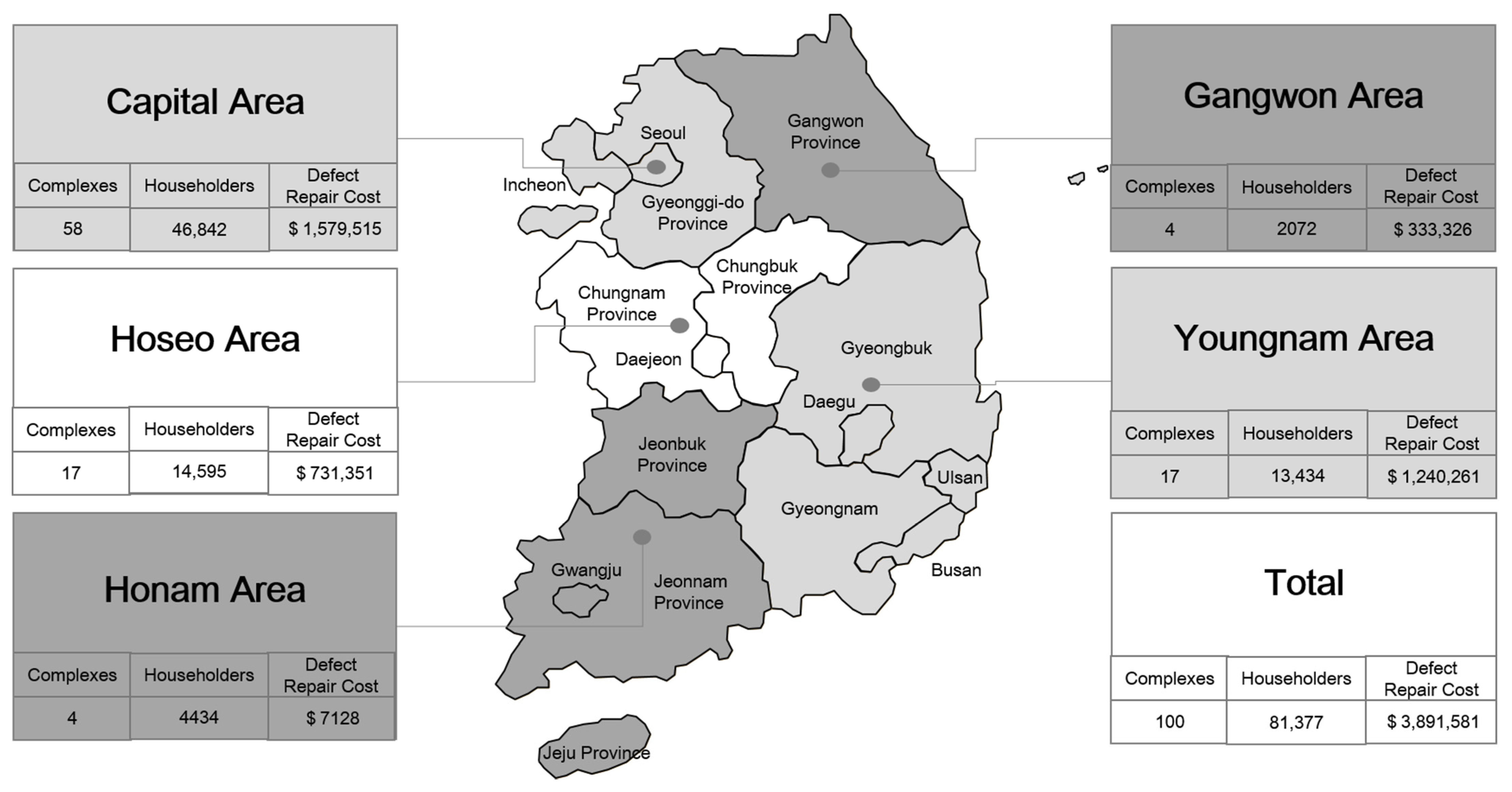
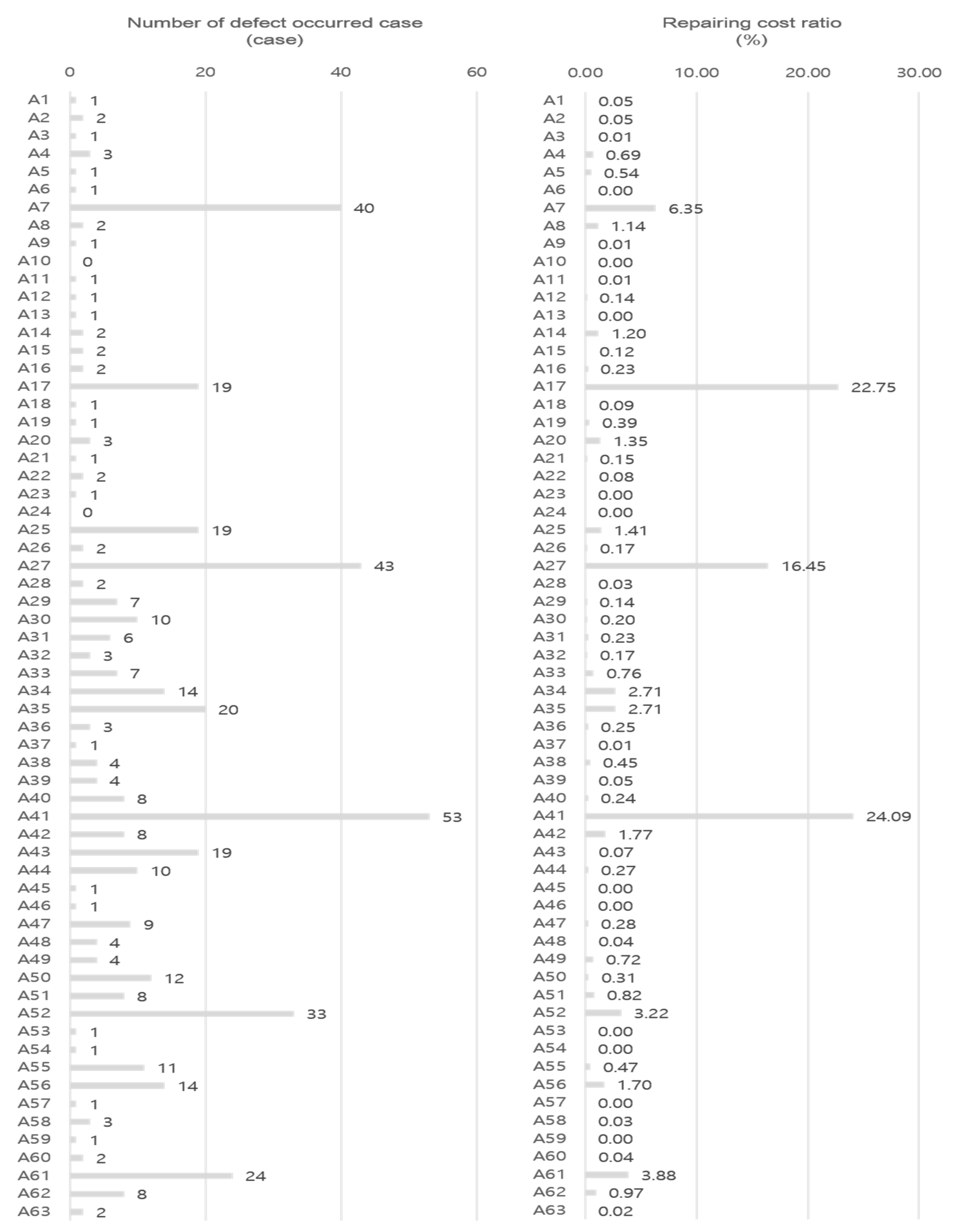
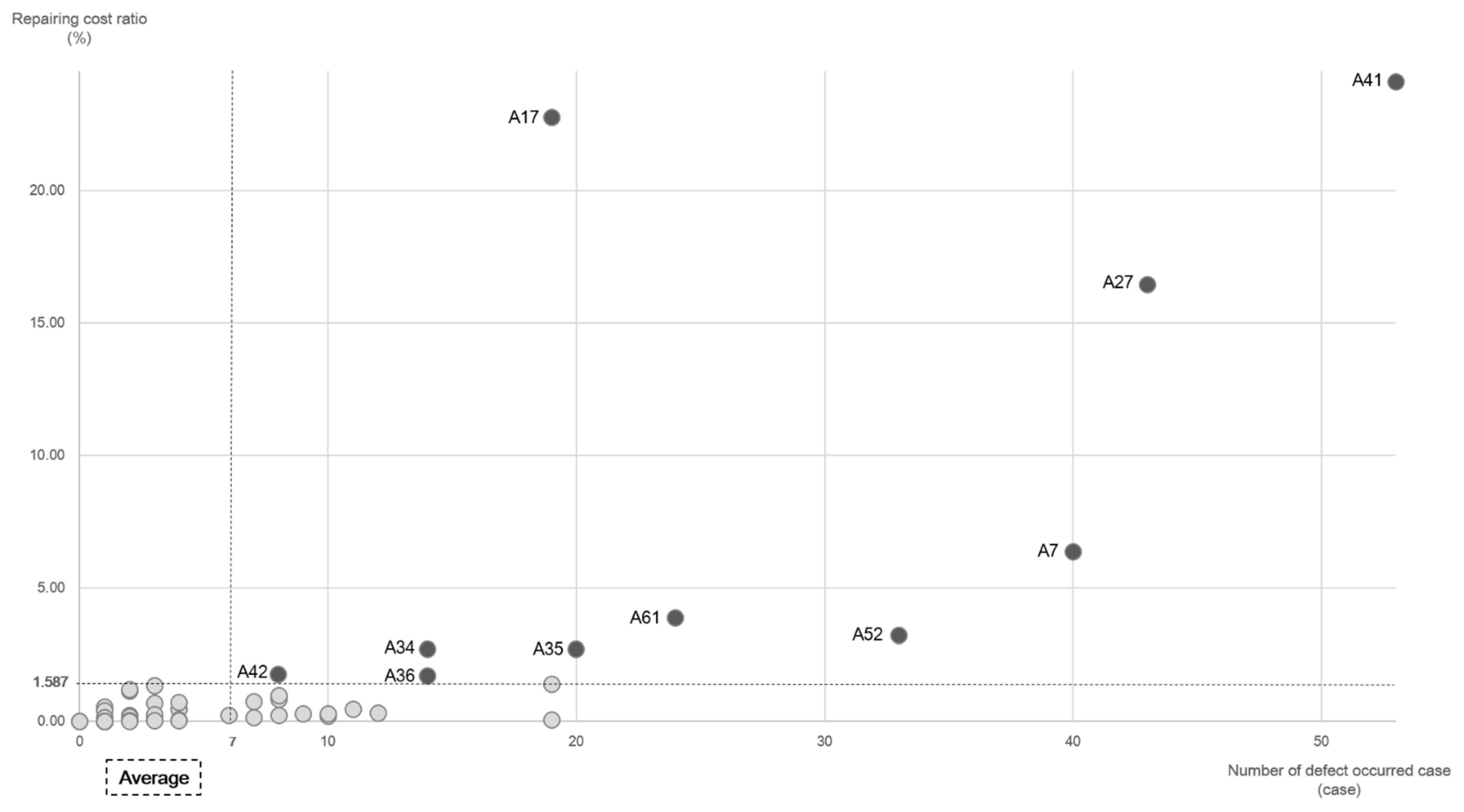
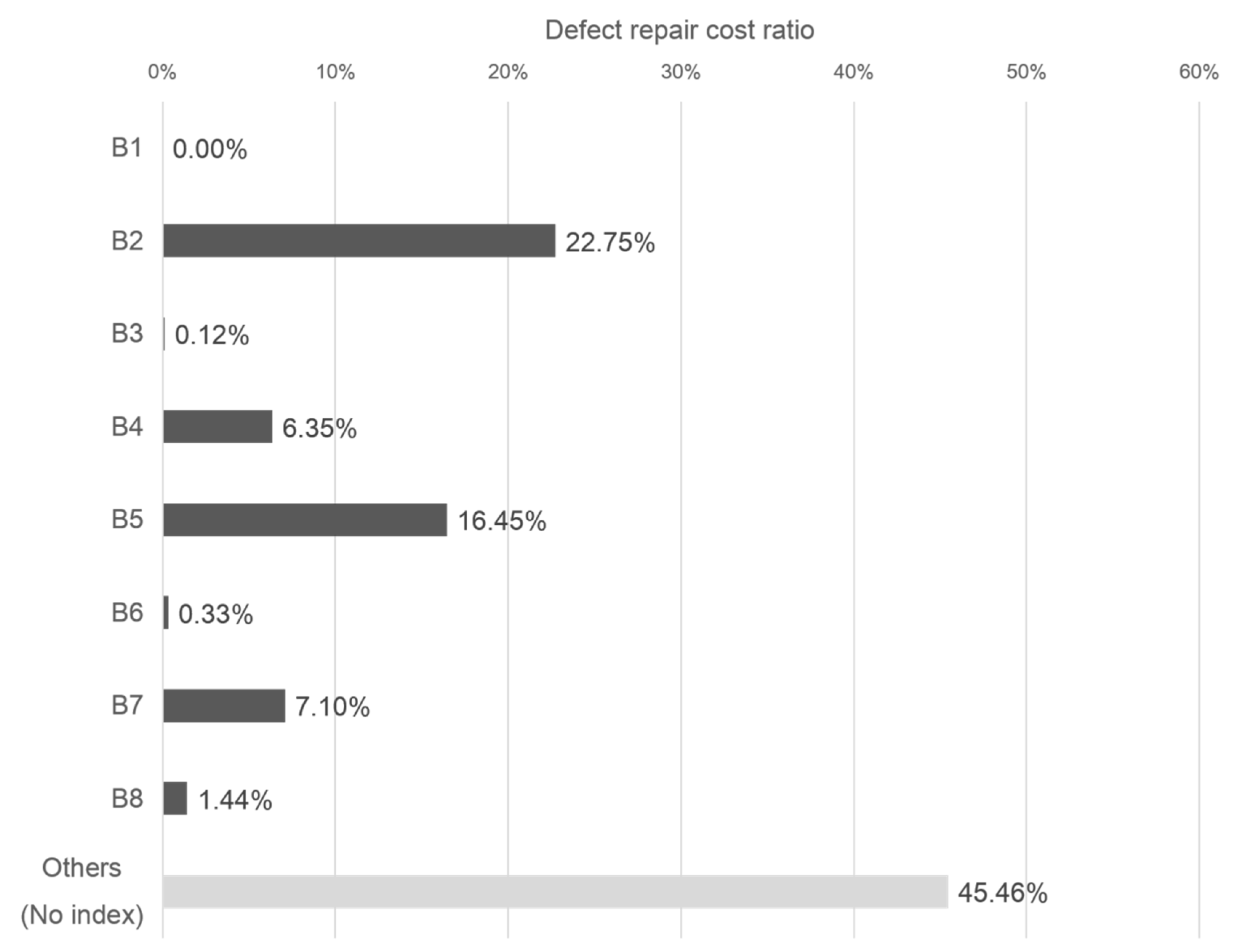
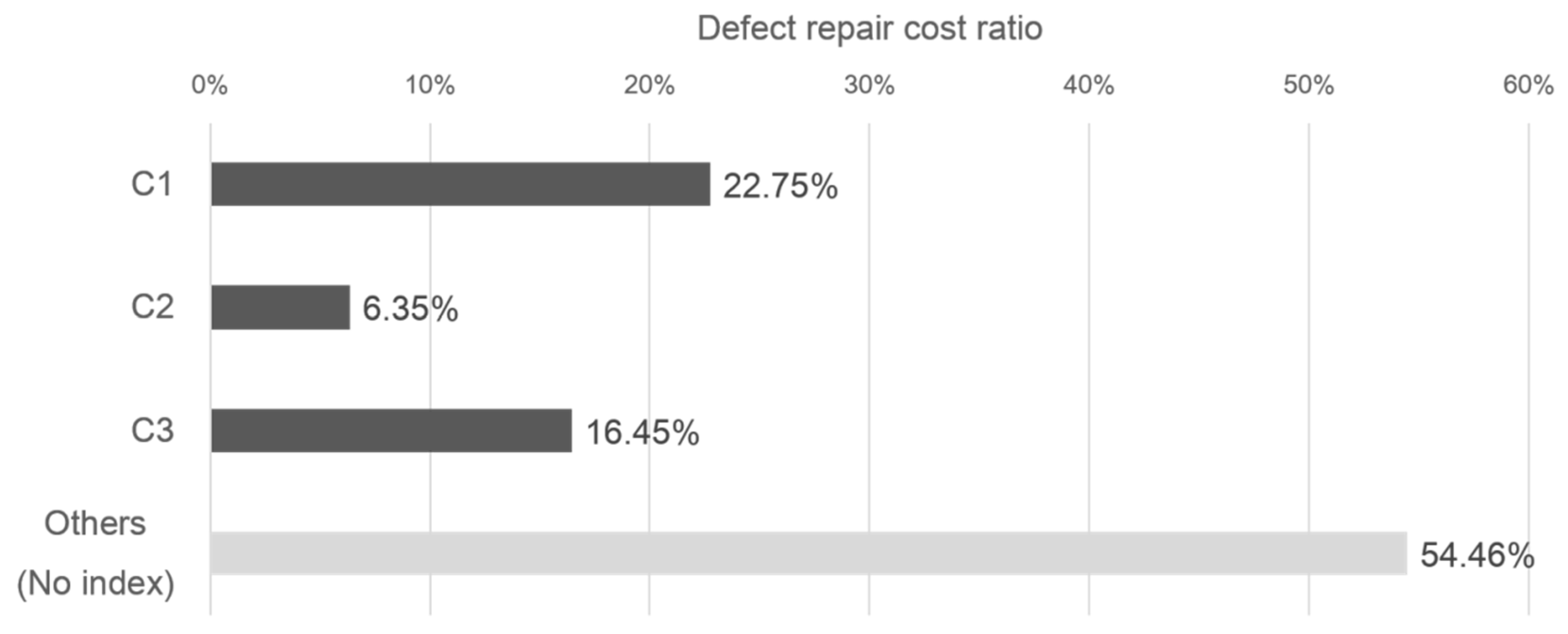
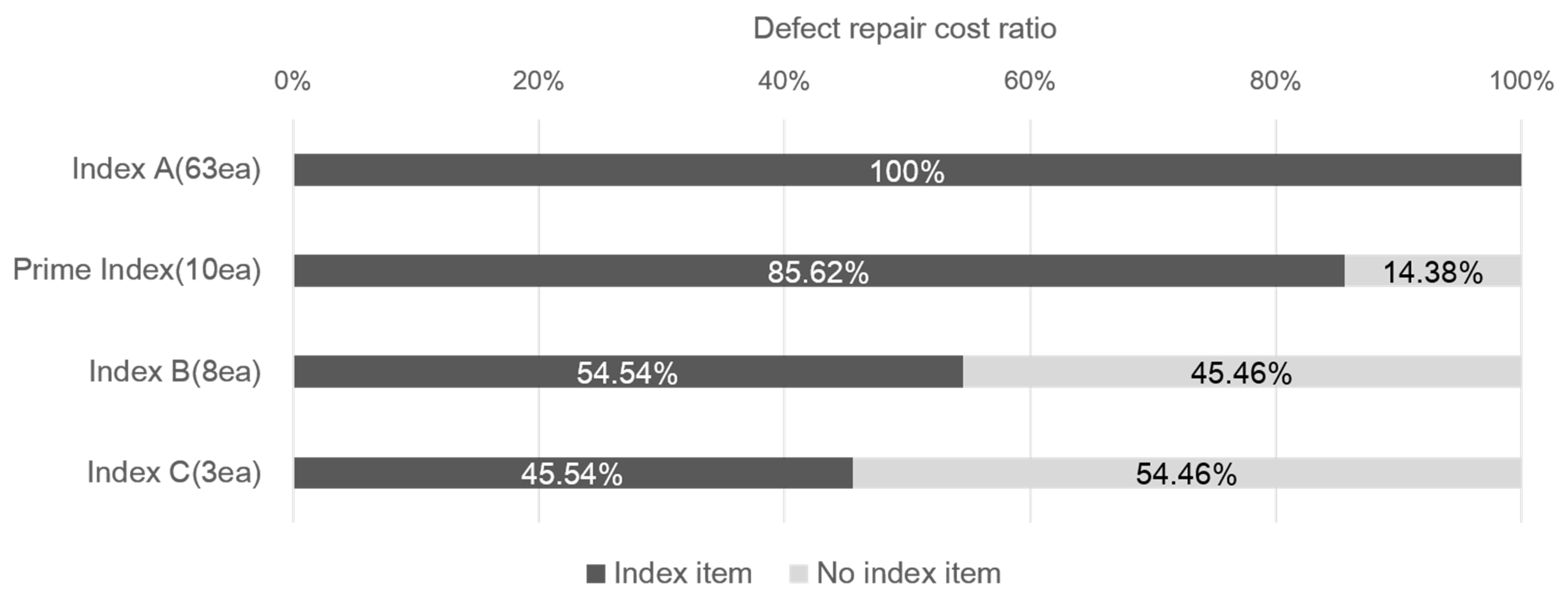
| Code | Occurring Time | Work | Location | Object | Phenomena |
| Code | Occurring Time | Work | Location | Object | Phenomena |
|---|---|---|---|---|---|
| A1 | occurring defect before handover | wooden structure work | ceiling | hanger | non-installation |
| A2 | frame | unmatched size | |||
| A3 | height | mismatch withdrawing | |||
| A4 | molding | non-installation | |||
| A5 | window and door work | door frame | excessive gap | ||
| A6 | finishing | non-installation | |||
| A7 | door | anti-rotting of end pieces | non-installation | ||
| A8 | opening direction | overlap | |||
| A9 | window and door | non-installation | |||
| A10 | attachment | non-installation | |||
| A11 | window and door | mismatch withdrawing | |||
| A12 | others | caulking | non-installation | ||
| A13 | finishing work | ceiling | molding | mismatch withdrawing | |
| A14 | finishing | mismatch withdrawing | |||
| A15 | skirting board | mismatch withdrawing | |||
| A16 | wooden floor | non-installation | |||
| A17 | under kitchen system | non-installation | |||
| A18 | interior furniture | attachment | non-installation | ||
| A19 | mismatch withdrawing | ||||
| A20 | mismatch with industrial standard | ||||
| A21 | non-installation | ||||
| A22 | miscellaneous work | kitchen system | opening direction | overlap | |
| A23 | attachment | non-installation | |||
| A24 | occurring defect after handover | wooden structure work | ceiling | structural part | malfunction |
| A25 | molding | malfunction | |||
| A26 | malfunction | ||||
| A27 | window and door work | window and door | opening and closing fault | ||
| A28 | finishing | drop out | |||
| A29 | door frame | finishing | malfunction | ||
| A30 | flexure | ||||
| A31 | fault of attachment | ||||
| A32 | breakage | ||||
| A33 | door | malfunction | |||
| A34 | flexure | ||||
| A35 | cover sheet | drop out | |||
| A36 | bottom and end header | rotting | |||
| A37 | drop out | ||||
| A38 | attachment | door lock | malfunction | ||
| A39 | door hinge | malfunction | |||
| A40 | others | caulking | malfunction | ||
| A41 | finishing work | floor | wooden floor | discoloration and breakage | |
| A42 | wall | wooden wall | malfunction | ||
| A43 | skirting board | wooden skirting board | malfunction | ||
| A44 | ceiling | wooden ceiling | malfunction | ||
| A45 | wooden lighting box | malfunction | |||
| A46 | wooden curtain box | malfunction | |||
| A47 | well type wooden ceiling | malfunction | |||
| A48 | others | caulking | malfunction | ||
| A49 | cover sheet | drop out | |||
| A50 | interior furniture | fault of attachment | |||
| A51 | breakage | ||||
| A52 | opening and closing fault | ||||
| A53 | door hinge | malfunction | |||
| A54 | molding | malfunction | |||
| A55 | cover sheet | drop out | |||
| A56 | miscellaneous work | kitchen system | malfunction | ||
| A57 | breakage | ||||
| A58 | fault of attachment | ||||
| A59 | molding | malfunction | |||
| A60 | door hinge | malfunction | |||
| A61 | door | opening and closing fault | |||
| A62 | cover sheet | drop out | |||
| A63 | others | caulking | malfunction |
| Code | Location | Detailed Object | Phenomena |
|---|---|---|---|
| B1 | ceiling | hanger | unmatched frame distance |
| B2 | wooden floor | under kitchen system | non-installation |
| B3 | skirting board | mismatch withdrawing | |
| B4 | door | anti-rotting of end pieces | non-installation |
| B5 | window and door | opening and closing fault | |
| B6 | interior furniture and kitchen system | fault of attachment | |
| B7 | opening and closing fault | ||
| B8 | cover sheet | drop out | |
| others (no index) |
| Code | Location | Detailed Object | Phenomena |
|---|---|---|---|
| C1 | wooden floor | under kitchen system | non-installation |
| C2 | door | anti-rotting of end pieces | non-installation |
| C3 | window and door | opening and closing fault | |
| others (no index) |
Publisher’s Note: MDPI stays neutral with regard to jurisdictional claims in published maps and institutional affiliations. |
© 2021 by the authors. Licensee MDPI, Basel, Switzerland. This article is an open access article distributed under the terms and conditions of the Creative Commons Attribution (CC BY) license (https://creativecommons.org/licenses/by/4.0/).
Share and Cite
Park, J.; Seo, D. Defect Index of Timberwork in House, Korea. Forests 2021, 12, 896. https://doi.org/10.3390/f12070896
Park J, Seo D. Defect Index of Timberwork in House, Korea. Forests. 2021; 12(7):896. https://doi.org/10.3390/f12070896
Chicago/Turabian StylePark, Junmo, and Deokseok Seo. 2021. "Defect Index of Timberwork in House, Korea" Forests 12, no. 7: 896. https://doi.org/10.3390/f12070896
APA StylePark, J., & Seo, D. (2021). Defect Index of Timberwork in House, Korea. Forests, 12(7), 896. https://doi.org/10.3390/f12070896






